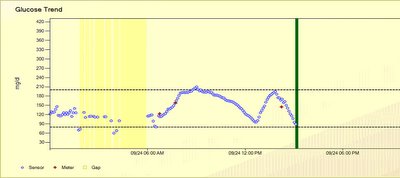New Sensor Longevity Record
I've been away a few days, so haven't had a chance to blog. My family and I traveled to New Jersey over the long Columbus Day weekend to see Godspell at the Paper Mill Playhouse. Excellent show, updated for the current times. Rap wasn't around in the 70s. I was concerned during the show that my DexCom CGMS might sound off, but fortunately, it didn't! I wish they'd add a vibrate all feature, similar to my Verizon Razr phone. I'm paranoid about it going off in church, the theater, or a movie. So far, it hasn't happened, but it's only a matter of time.
Anyway, took a chance this past weekend and didn't bring an extra sensor. The sensor lasted the whole long weekend in addition to a week before that, for a total of 11 days inserted in my stomach. After removing the sensor, I saw only a tiny red bump, the same size and shape that I've seen after leaving the sensor in for 3 days. There was only a very mild pink area where the adhesive was; very encouraging; averaging that sensor cost over 11 days, that's less than $3.50 a day, very reasonable, at least for my pocketbook.
I think I'm going to change the sensors a max of every 10 days, even if some others have had them in longer. The last couple of days I thought that the sensor values were 50 or so points off from the Ultra meter, even after frequent calibration.
Only a month left until my next HBA1C; I've got my fingers crossed that this CGMS is really going to help me; I've modified my behaviors a great deal because of the CGMS; I'll be VERY DISAPPOINTED if I don't get some decent results!






